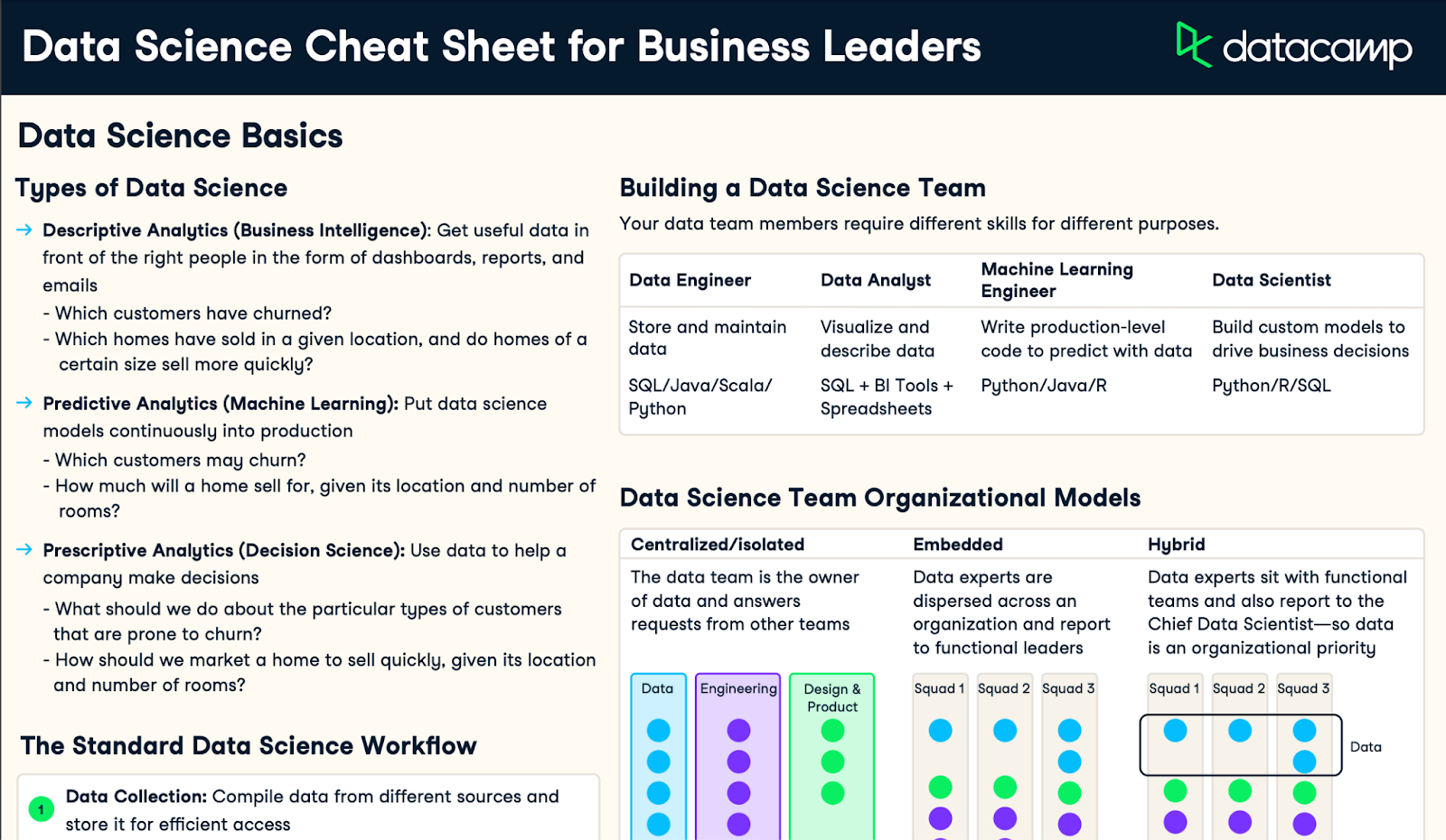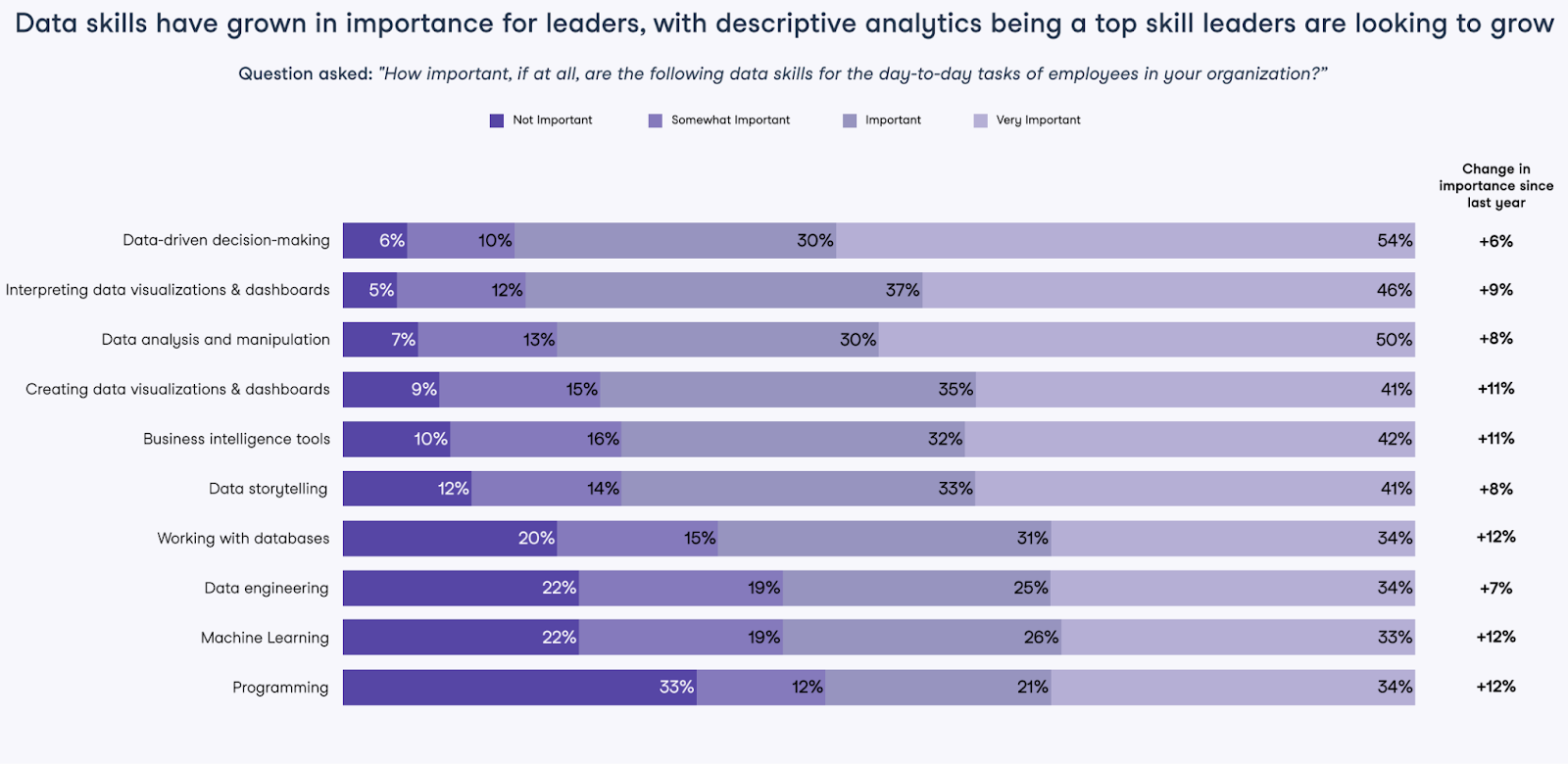Course
Digital transformation involves the integration of digital technologies into all aspects of an organization's operations, fundamentally altering how they function and deliver value. The idea is simple: establish a competitive edge in the marketplace by enhancing customer experience, while reducing costs.
Data practitioners play a crucial role in this process, as they’re required to leverage data to optimize strategies. Thus, digital transformation concepts are crucial for aspiring and junior data practitioners seeking to thrive in modern business.
In this article, we explore digital transformation and its key components, as well as what it looks like in different industries, with some examples. We’ll also cover its benefits, challenges, and risks. If you want a more hands-on approach, check out the course Digital Transformation Concepts. You can also view our webinar on Adding Value in Pharma Through Data & AI Transformation to learn more.
Empower Your Team with Data Literacy
Enhance your team's data literacy and decision-making capabilities with DataCamp for Business. Access diverse courses, hands-on projects, and centralized insights for teams of 2 or more.

What is Digital Transformation?
Digital transformation represents a fundamental change in how an organization delivers value to its customers. It entails integrating digital technologies into all aspects of business operations, aiming to use these technologies to launch new products and services, improve existing ones, and optimize processes. This approach aims to improve customer engagement, support employees, and increase the organization's overall business value.
However, the emergence of digital transformation as a crucial strategic initiative only began in the mid-2010s, propelled by the rise of mobile communications, cloud computing, data analytics, and other advanced technologies. Notable early examples like Uber, Airbnb, and Netflix utilized these technologies to redefine transactions and disrupt entire industries.
The COVID-19 pandemic further accelerated digital transformation, driving innovations to support remote and hybrid work. Post-pandemic, the rapid adoption of AI and immersive web technologies continues to present new opportunities and disruptions.
Essentially, digital transformation is the adoption and application of technologies to continually evolve and reinvent enterprises for growth and competitive strategy, rethinking how organizations use technology, people, and processes to pursue new business models and revenue streams driven by changing customer expectations.
Key Components of Digital Transformation
As stated, digital transformation involves a comprehensive overhaul of an organization's operations and strategy to leverage digital technologies. There are three core components that make this possible:
- Technology
- Organization
- People
By addressing each one, businesses can effectively implement their own digital transformation, enhance their operational capabilities, and maintain competitiveness in the evolving digital landscape.
Let’s dive deeper into each component to see what that looks like.
Technology
The technology component of digital transformation encompasses the integration and application of advanced digital tools to enhance business operations. Cloud computing can play a pivotal role by providing scalable and flexible access to resources and applications, enabling organizations to innovate and operate more efficiently.
Artificial intelligence (AI) and machine learning (ML) are critical for enhancing decision-making, automating complex processes, and delivering predictive analytics, which help anticipate customer needs and market trends.
The Internet of Things (IoT) connects various devices and systems, facilitating data collection, operational efficiency, and the creation of new business models. Additionally, emerging technologies such as blockchain offer secure and transparent transaction capabilities, further driving digital innovation.
Organization
Organizational changes are essential to accommodate and leverage digital transformation effectively. This often involves restructuring the organizational hierarchy to facilitate more agile and collaborative workflows. Businesses may be required to adopt flatter organizational structures to enhance communication and decision-making.
Cultural transformation is equally important; fostering a data culture of innovation, data-driven decision-making, and agility is crucial for adapting to new technologies and market conditions.
Leadership commitment is vital in guiding and supporting the digital transformation efforts, ensuring alignment with strategic goals and fostering a supportive environment for technological adoption and change.
People
The successful implementation of digital transformation hinges on acquiring the right skills and talent. Employees must develop proficiency in new technologies such as cloud computing, AI, and data analytics to drive innovation and efficiency.
Upskilling and reskilling programs are essential to equip staff with the necessary digital competencies. Organizations need to attract and retain talent with expertise in digital technologies, data science, and cybersecurity to navigate the complexities of digital transformation.
A focus on continuous learning and professional development ensures that the workforce remains adaptable and capable of leveraging new tools and technologies effectively.
DataCamp For Business specializes in upskilling teams of two or more in areas such as data and AI literacy. With hundreds of courses, tutorials, and projects, you can ensure that your people have hands-on experience to help drive your digital transformation.

Our Data Science Cheat Sheet for Business Leaders can help inspire your digital transformation
What are Digital Transformation Strategies?
Developing and implementing a digital transformation strategy involves several critical steps. I’ve broken them down into 7 essential ones:
Step 1: Goal and objective definition
The first thing to do is to clearly identify the business objectives and goals that the digital transformation aims to achieve. These might include improving customer experience, increasing operational efficiency, or creating new revenue streams. Establishing specific, measurable, achievable, relevant, and time-bound (SMART) goals helps ensure the strategy aligns with broader business aims.
Step 2: Audit
Next, you want to know where you currently stand. Conduct a thorough assessment of existing technologies, processes, and organizational structures. Identify gaps and areas for improvement to understand where digital transformation can have the most impact. This assessment includes evaluating current IT infrastructure, employee skills, and customer interactions. DataCamp’s Data Maturity Assessment is a useful tool.
Step 3: Establish new processes and create your roadmap
Existing operational methods may not align with your digital transformation efforts. Therefore, developing and implementing new processes is essential for your organization to thrive. For some companies, this means completely revamping their processes. To effectively manage this transition, it’s important to unite employees, ensuring they grasp the changes, understand their responsibilities, and know how new systems will support the team.
Step 4: Selecting your technologies
You don't need every available technology for a successful digital transformation. Instead, focus on selecting technologies that support your key processes and align with your goals. Identify what matters most to your organization and find technologies, such as cloud computing, AI, or data analytics, that meet those needs. Ensure these tools integrate seamlessly with your existing systems and can scale as required.
Step 5: Fostering organizational change
Prepare for this change by promoting a culture of innovation and agility, restructuring teams, redefining roles, and encouraging cross-departmental collaboration. Leadership must actively support and communicate these efforts to ensure stakeholder buy-in.
This is where tools like DataCamp For Business can help. With a catalog of courses and resources for upskilling your workforce, you can develop customized learning paths for employees at your organization, so your employees can quickly learn the essential data and Al skills that are relevant to your digital transformation.
Training 2 or more people? Check out our Business solutions
Get your team access to the full DataCamp library, with centralized reporting, assignments, projects and more

Step 6: Implement and monitor
Once you've completed the prep work, it's time to put your plan into action. Given its complexity, don't try to implement all changes at once. Instead, work in iterations. An iterative approach allows for flexibility, with stages lasting from a week to a month.
At the start of each week, gather your team to break the plan into specific tasks. Review progress, ensure everything is on track, and address any issues that might need adjustments. Follow the digital transformation plan according to the roadmap you created in step 3, and regularly monitor progress against milestones and metrics. This includes tracking technology adoption, process improvements, and meeting your goals.
Step 7: Evaluate and adapt
Continuously evaluate the outcomes of the transformation efforts. Gather feedback from stakeholders and assess whether the transformation meets the defined objectives. Be prepared to adapt the strategy based on performance results and evolving business needs.
Aligning Digital Transformation Strategies with Business Goals
Aligning the digital transformation strategy with business goals is essential, as it ensure the technological investments yield real benefits. A well-aligned strategy means the digital efforts directly support organizational objectives, like boosting customer satisfaction, cutting costs, or growing market share. When the strategy matches the business goals, it maximizes ROI and drives significant improvements in performance and competitiveness – and this is what the C-suite wants.
To see some digital transformation best practices, it’s good to check out some examples of successful strategies from leading companies – here are three:
Amazon
Amazon’s digital transformation strategy primarily focuses on leveraging technology to enhance customer experience and streamline operations.
For example, their most significant digital transformation was introduced in 2005: Amazon Prime. This service offered customers a bundle of benefits that enhanced their experience, such as:
- Free two-day shipping on eligible products
- Access to a vast library of streaming content
- Exclusive discounts
Prime fundamentally altered how people shopped online – it was a complete game-changer.
Another bold move by Amazon was their introduction of Amazon Web Services, their cloud computing platform, in 2006. AWS provided businesses with scalable and affordable cloud infrastructure and services, removing the necessity for costly on-premises data centers and infrastructure. This digital transformation was revolutionary, and enabled Amazon to quickly establish themself as a leading force in the cloud computing industry.
By integrating AI and machine learning into its supply chain and personalization algorithms, Amazon has set a standard in e-commerce and cloud computing through AWS.
Netflix
Netflix transformed the entertainment industry through its innovative digital strategy. They entered the market as a disruptor of traditional video stores like Blockbuster, but the founders, Reed Hastings and Marc Randolph, were eager to introduce customer-centricity to the video rental market.
This was a period when renting videos had become extremely inconvenient and costly. Customers were regularly hit with expensive late fees, which negatively impacted the customer experience.
Consequently, Netflix took its first step into the world of streaming video in 2007. This was an entirely new way to watch movies. They provided customers with a streaming subscription alongside the traditional DVD rental service, allowing individuals to choose their preferred way to access content. But as time went on, subscribers for their video streaming service grew. Since then, they’ve seen exponential growth in subscribers and revenue.
The company's shift from DVD rentals to streaming services exemplifies successful digital disruption and adaptation to changing consumer behaviors. More recently, Netflix began leveraging data analytics and AI to personalize content recommendations, which keeps customers coming back for more.
General Electric (GE)
GE’s digital transformation began around seven years ago. What started as a modest evaluation of the automotive industry in 2015, aimed at finding improved methods for product design and measurement, has evolved into a company-wide initiative impacting every aspect of the business.
Their strategy involves integrating IoT and data analytics into its industrial operations. The company has since developed the Predix platform to analyze data from industrial machines, improving operational efficiency and creating new service models.
The Benefits of Digital Transformation
To recap what we’ve mentioned so far: businesses must embrace digital trends to stand out in a competitive market. Efficient software helps companies meet market demands by boosting productivity and increasing revenue. Digital transformation involves adopting new technologies, enhancing existing ones, and changing business models and processes. It also encompasses cultural change.
Implementing such changes can bring several benefits, as you can see below:
Improved efficiency and productivity
Digital transformation can greatly enhance a business's efficiency by automating repetitive tasks, minimizing errors, and boosting productivity. For instance, a company may adopt a cloud-based solution that enables employees to access data and collaborate more effectively from any location around the world. This improved efficiency means employees can focus on higher-value tasks, further boosting overall productivity and operational efficiency.
Enhanced customer experiences
According to PwC, 54% of U.S. consumers say customer experience at most companies needs improvement. Hence why nearly half of the companies who want to start their digital transformation say customer experience and satisfaction is at the forefront.
By leveraging digital tools and data analytics, companies can gain deeper insights into customer preferences and behaviors. This enables personalized interactions and tailored services, significantly improving customer satisfaction and loyalty. Enhanced customer experiences drive repeat business and positive word-of-mouth.
Greater business agility and innovation
Gartner reports that 56% of CEOs indicate that digital enhancements have led to increased revenue. This is because organizations become more adaptable to market changes and can quickly pivot strategies in response to new opportunities or threats. This agility supports innovation, allowing companies to develop new products, services, and business models that drive growth and competitive advantage.
Increased collaboration and communication
Digital tools facilitate better communication and collaboration among teams, regardless of geographical location. This connectivity enhances teamwork, accelerates decision-making, and fosters a more cohesive organizational culture. CompTIA suggests that 41% of organizations will place a greater emphasis on communication and new technology skills to enhance remote work.
Data-driven decision making
Access to real-time data and advanced analytics empowers businesses to make informed decisions quickly. Data-driven insights also help to identify trends, predict outcomes, and optimize strategies, leading to more effective and strategic planning.
We asked leaders to rank the data skills they deem most important for their teams. The results underscore a clear emphasis on data-driven decision-making and making sense of complex datasets. Leading the pack, 84% of leaders pointed to data-driven decision-making as the most important skill for their teams (up by 6% since last year).

Stats from the State of Data & AI Literacy Report
Cost Savings
According to Fujitsu, one of the key drivers of digital transformation in retail is improved efficiency and reduced costs (69%). That said, automating processes and optimizing resource utilization can lead to significant cost reductions. Digital transformation helps eliminate inefficiencies, reducing operational costs, and improving the overall financial health of the organization.
Improved compliance and security
A key technology that serves as a major factor in the push for digital transformation is cybersecurity solutions. As more companies get onboard with digital transformation, the surface area digital attacks expands. But digital tools can also enhance data security and ensure compliance with regulatory standards. Implementing robust cybersecurity measures and automated compliance checks reduces the risk of data breaches and legal issues, safeguarding the organization’s reputation and assets.
Better employee engagement and satisfaction
Providing employees with modern tools and technologies enhances their work experience and job satisfaction.
Digital Transformation Challenges and Risks
DataCamp’s 2024 Data Literacy report found that 86% of leaders believe data literacy is important for their teams’ day-to-day tasks. Moreover, 62% of leaders believe AI literacy is now important for their teams’ day-to-day tasks.
However, another report from McKinsey & Company revealed that fewer than 30% of companies succeed in their digital transformation efforts, and only 16% reported that their plans improved performance and led to lasting changes. That’s to say, digital transformation is not without its challenges and risks.
Some common challenges organizations are likely to encounter and how to mitigate them include:
Resistance to change
According to Mckinsey, 70% of digital transformations fail, most often due to resistance from employees. DataCamp’s 2024 State of Data & AI Literacy report also discovered that 28% of leaders struggle filling skill gaps employee due to resistance. One reason for this could be that employees may be reluctant to adapt to new technologies or processes, but it can also stem from fear of the unknown or discomfort with changing their established routines.
Business leaders must address this resistance by promoting a culture of innovation and continuous improvement. It’s their duty to communicate the benefits of digital transformation clearly and involve employees in the process to gain their support.
Lack of clear vision and strategy
One of the underlying reasons leaders view digital transformation as important is because of how it can improve decision-making. According to the Data Literacy Report, inaccurate (42%) and slow (38%) decisions emerged as the biggest risks leaders face. But without a well-defined digital transformation strategy, organizations will struggle altogether.
Aligning their initiatives with business goals would be hard, leading to wasted resources and missed opportunities. This is why business leaders must create a comprehensive digital transformation strategy that aligns with their business goals.
Inadequate technology integration
Integrating new digital tools with existing systems can be complex and may result in technical difficulties or disruptions to ongoing operations. Thus, organizations must plan for smooth integration by selecting technologies that are compatible with your existing systems. The best way to do this is to iInvest in adequate testing and seek support from vendors to address integration challenges.
Skill gaps
PwC suggests that 55% of employers most worried about digital transformation say innovation is hampered by a lack of key skills.In the DataCamp Data & AI Literacy Report, inadequate training resources emerged as the second major hurdle businesses face when filling skill gaps required for digital transformation. This was highlighted by 33% of leaders who pointed to the quality of learning materials as a key issue.
A notable 29% of leaders find that video-based courses make it difficult to apply learned skills in the real world, pointing to lack of interactivity as the biggest challenge with online learning. Similarly, 29% of leaders point to employee confusion about where to get started as the biggest challenge they face with online learning providers.
High costs
One of the biggest challenges of digital transformation are the costs of implementation. Fujitsu conducted a survey among retailers and discovered 75% of them believe the upfront cost are significantly challenging.
When leaders were asked to identify the top challenges in training their teams for DataCamp’s 2024 Data Literacy report, 35% cited a lack of budget as the primary obstacle. This represents a slight improvement from the 40% reported last year but remains the most significant barrier to the transformation of data and AI skills.
Lack of ownership
When leaders were asked what challenges they faced when improving their workforce data and AI skills, 26% of them responded that a lack of executive support and clear ownership of training programs as significant obstacles to successful upskilling.
Conclusion
In summary, digital transformation is a dynamic process that reshapes how businesses operate, interact with customers, and drive innovation. For aspiring and junior data practitioners, understanding this transformation is essential, as it involves leveraging advanced technologies and data-driven strategies to optimize processes and achieve business objectives.
Embracing digital tools like AI, cloud computing, and data analytics will empower you to contribute meaningfully to these efforts, improving efficiency and fostering a culture of continuous improvement. Grasping the core components and strategies of digital transformation will equip you to play a pivotal role in shaping the future of business in an increasingly digital world.
Now check out these resources to continue your learning:
Digital Transformation FAQs
What are the four main areas of digital transformation?
The four main areas of digital transformation are customer experience, operational efficiency, business model transformation, and cultural and organizational transformation
What are the three keys to digital transformation?
People, processes/organization, and technology
Why does digital transformation fail?
Digital transformation projects often falter without a solid change management strategy. This strategy provides a structured approach to help people understand and adapt to changes within the business. Organizations that implement effective change management are much more likely to achieve their digital transformation objectives.
What is the main purpose of digital transformation?
The main purpose of digital transformation is to improve operations, enhance customer experiences, and drive innovation. It also helps to boost efficiency, adapt to market changes, and create new value propositions for sustained competitive advantage.

